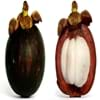Health Benefits
Good for diabetics, Improves well-being, Miraculin/miracle fruit makes sour things taste sweet
Anti depressant, Cancer prevention, Reduces nervous tension, Treatment of alzheimer's disease, Treatment of Lung disease
General Benefits
Has taste modifying effect
Digestive aid, Helps in weight loss, Improves blood circulation, Strengthens bones, Treatment of common cold
Skin Benefits
NA
Brightens and lightens complexion, Skin rejuvenation
Hair Benefits
NA
Promotes longer and healthier hair, Protects hair
Allergy Symptoms
Itching, Skin rash
NA
Side Effects
Changes taste of food eaten after this fruit, Coagulation
Allergic reaction
Best Time to Eat
As a snack in the late afternoon, Eat the fresh ones, avoid mixing with any other foods, don't eat after meal., Morning time (before lunch)
As a snack in the late afternoon, Don't consume at night and before bed, Eat the fresh ones, avoid mixing with any other foods, don't eat after meal., Morning time (before lunch)
Protein to Carb Ratio
Not Available
Vitamin B1 (Thiamin)
Not Available
Vitamin B2 (Riboflavin)
Not Available
Vitamin B3 (Niacin)
Not Available
Vitamin B5 (Pantothenic Acid)
Not Available
Vitamin B6 (Pyridoxin)
Not Available
Vitamin B9 (Folic acid)
Not Available
Vitamin C (Ascorbic Acid)
Vitamin K (Phyllochinone)
Not Available
Lutein+Zeaxanthin
Not Available
Water Content
Not Available
Calories in Fresh Fruit with Peel
Not Available
Not Available
Calories in Fresh Fruit without Peel
Not Available
Calories in Frozen Form
Not Available
Not Available
Calories in Dried Form
Not Available
Calories in Canned Form
Not Available
Not Available
Calories in Juice
Not Available
Calories in Jam
Not Available
Calories in Pie
Not Available
Season
Monsoon
Autumn, Winter
Varieties
Gymnema Sylvestre and Thaumatococcus Daniellii
Anatoki, Gemini, Kaiteri, Kakariki, Pounamu, Unique, Apollo, Den's Choice, Kakapo, Mammoth, Opal Star, Triumph and Wiki Tu
Inside Color
Greyish-white
White
Origin
West Africa
Argentina, Brazil, Paraguay, Uruguay
Grows on
Trees
Not Available
Soil Type
Well-drained
Clay loam, Gravely loam, Sandy
Climatic Conditions
Rainfall
Cold, Warm
Facts about
- The name 'Miracle' because of the magical experience you get after eating it.
- When you have lemon after eating this fruit, it tastes sweet as if it is added with sugar.
- It is also used as natural sweetener.
- Feijoa is called as "pineapple guava" in some countries.
- Feijoa tree is an ornamental plant that can also be used as hedge & windbreak.
- All parts of feijoa fruit are edible(skin is mostly discarded).
Top Producer
NA
New Zealand
Other Countries
NA
Australia, Azerbaijan, India, Japan, United States of America
Top Importer
Not Available
China
Top Exporter
United States of America
New Zealand
Botanical Name
Synsepalum Dulcificum
Acca sellowiana
Synonym
Miracle Berry, Miraculous Berry and Sweet Berry
Feijoa sellowiana or Orthostemon sellowianus
Subkingdom
Tracheobionta
Tracheobionta
Division
NA
Magnoliophyta
Subclass
Asteridae
Rosidae
Family
Sapotaceae
Myrtaceae
Species
S. dulcificum
A. sellowiana
Generic Group
Not Available
Myrtle
Difference Between Miracle fruit and Feijoa
We might think that Miracle fruit and Feijoa are similar with respect to nutritional value and health benefits. But the nutrient content of both fruits is different. Miracle fruit and Feijoa Facts such as their taste, shape, color, and size are also distinct. The difference between Miracle fruit and Feijoa is explained here.
The amount of calories in 100 gm of fresh Miracle fruit and Feijoa with peel is Not Available and Not Available and the amount of calories without peel is Not Available and 55.00 kcal respectively. Thus, Miracle fruit and Feijoa belong to Low Calorie Fruits and Low Calorie Fruits category.These fruits might or might not differ with respect to their scientific classification. The order of Miracle fruit and Feijoa is Ericales and Myrtales respectively. Miracle fruit belongs to Sapotaceae family and Feijoa belongs to Myrtaceae family. Miracle fruit belongs to Synsepalum genus of S. dulcificum species and Feijoa belongs to Acca genus of A. sellowiana species. Beings plants, both fruits belong to Plantae Kingdom.









